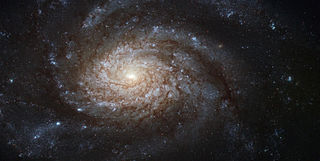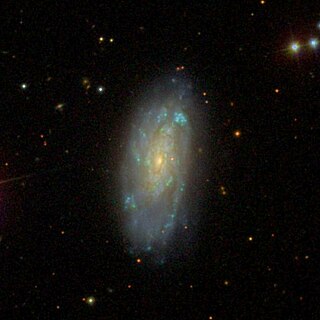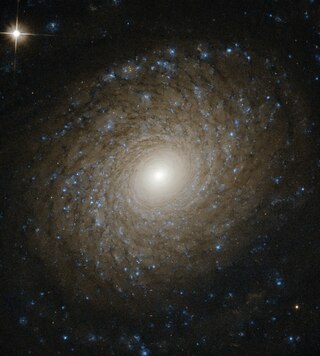The Ursa Major Cluster is a spiral-rich galaxy cluster of the Virgo Supercluster.

NGC 4088 is an intermediate spiral galaxy in the constellation Ursa Major. The galaxy forms a physical pair with NGC 4085, which is located 11′ away.

The M109 Group is a group of galaxies about 55 million light-years away in the constellation Ursa Major. The group is named after the brightest galaxy within the group, the spiral galaxy M109.

NGC 5474 is a peculiar dwarf galaxy in the constellation Ursa Major. It is one of several companion galaxies of the Pinwheel Galaxy (M101), a grand-design spiral galaxy. Among the Pinwheel Galaxy's companions, this galaxy is the closest to the Pinwheel Galaxy itself. The gravitational interaction between NGC 5474 and the Pinwheel Galaxy has strongly distorted the former. As a result, the disk is offset relative to the nucleus. The star formation in this galaxy is also offset from the nucleus. NGC 5474 shows some signs of a spiral structure. As a result, this galaxy is often classified as a dwarf spiral galaxy, a relatively rare group of dwarf galaxies.

NGC 3718, also called Arp 214, is a galaxy located approximately 52 million light years from Earth in the constellation Ursa Major. It is either a lenticular or spiral galaxy.

NGC 1964 is a barred spiral galaxy in the constellation Lepus. The galaxy lies 65 million light years away from Earth, which means, given its apparent dimensions, that NGC 1964 is approximately 100,000 light years across. At its center lies a supermassive black hole, with estimated mass 2.5 × 107M☉. The galaxy features two tightly wound inner spiral arms within a disk with high surface brightness and two outer, more open spiral arms that originate near the inner ring. The outer arms feature few small HII regions.

NGC 3642 is a spiral galaxy in the constellation Ursa Major. The galaxy has a low-ionization nuclear emission-line region. It is located at a distance of circa 30 million light years from Earth, which, given its apparent dimensions, means that NGC 3642 is about 50,000 light years across. The galaxy is characterised by an outer pseudoring, which was probably formed after the accretion of a gas rich dwarf galaxy.

NGC 3941 is a barred lenticular galaxy located in the constellation Ursa Major. It is located at a distance of circa 40 million light years from Earth, which, given its apparent dimensions, means that NGC 3941 is about 40,000 light years across. It was discovered by William Herschel in 1787.

NGC 4026 is an edge-on lenticular galaxy in the constellation Ursa Major. It is located at a distance of circa 50 million light years from Earth, which, given its apparent dimensions, means that NGC 4026 is about 80,000 light years across. It was discovered by William Herschel on April 12, 1789.

NGC 3631 is a spiral galaxy located in the constellation Ursa Major. It is located at a distance of about 35 million light years from Earth, which, given its apparent dimensions, means that NGC 3631 is about 60,000 light years across. It was discovered by William Herschel on April 14, 1789. It is a grand design spiral galaxy seen face on.

NGC 3726 is a barred spiral galaxy located in the constellation Ursa Major. It is located at a distance of circa 45 million light years from Earth, which, given its apparent dimensions, means that NGC 3726 is about 85,000 light years across. It was discovered by William Herschel on February 5, 1788.

NGC 3810 is a spiral galaxy located in the constellation Leo. It is about 50 million light years from Earth, and estimated to be about 60,000 light years in diameter. William Herschel discovered it on 15 March 1784.

NGC 3893 is a spiral galaxy located in the constellation Ursa Major. It is located at a distance of circa 50 million light years from Earth, which, given its apparent dimensions, means that NGC 3893 is about 70,000 light years across. It was discovered by William Herschel on February 9, 1788. NGC 3893 interacts with its satellite, NGC 3896.

NGC 7723 is a barred spiral galaxy located in the constellation Aquarius. It is located at a distance of circa 90 million light years from Earth, which, given its apparent dimensions, means that NGC 7723 is about 95,000 light years across. It was discovered by William Herschel on November 27, 1785. The galaxy is included in the Herschel 400 Catalogue. It lies 1.5 degrees north-northwest from Omega1 Aquarii. It can be seen with a 4-inch telescope under dark skies.

NGC 5468 is an intermediate spiral galaxy located in the constellation Virgo. It is located at a distance of about 140 million light-years from Earth, which, given its apparent dimensions, means that NGC 5468 is about 110,000 light-years across. It was discovered by William Herschel on March 5, 1785.

NGC 7448 is a spiral galaxy located in the constellation Pegasus. It is located at a distance of circa 80 million light years from Earth, which, given its apparent dimensions, means that NGC 7448 is about 60,000 light years across. It was discovered by William Herschel on October 16, 1784. It is included in the Atlas of Peculiar Galaxies in the category galaxies with detached segments.

NGC 779 is a spiral galaxy seen edge-on, located in the constellation Cetus. It is located at a distance of circa 60 million light years from Earth, which, given its apparent dimensions, means that NGC 779 is about 70,000 light years across. It was discovered by William Herschel on September 10, 1785.

NGC 2985 is a spiral galaxy located in the constellation Ursa Major. It is located at a distance of circa 70 million light years from Earth, which, given its apparent dimensions, means that NGC 2985 is about 95,000 light years across. It was discovered by William Herschel on April 3, 1785.

NGC 3729 is a barred spiral galaxy located in the constellation Ursa Major. It is located at a distance of circa 65 million light years from Earth, which, given its apparent dimensions, means that NGC 3729 is about 60,000 light years across. It was discovered by William Herschel on April 12, 1789.

NGC 4096 is a spiral galaxy in the constellation Ursa Major. The galaxy lies about 35 million light years away from Earth, which means, given its apparent dimensions, that NGC 4096 is approximately 80,000 light years across. It was discovered by William Herschel on March 9, 1788.



















